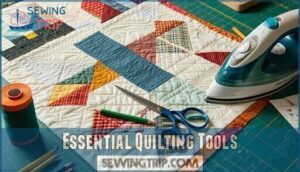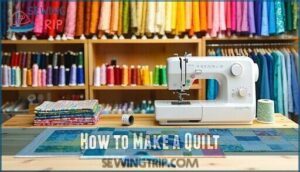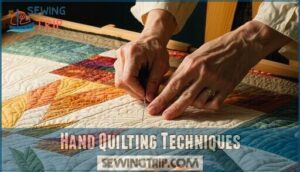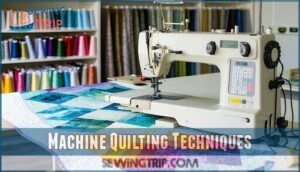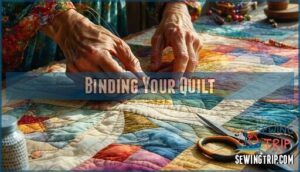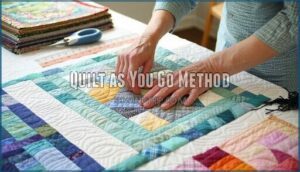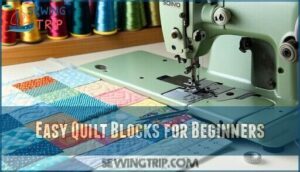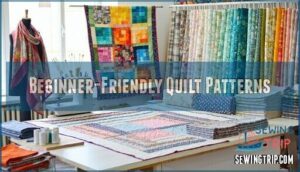This site is supported by our readers. We may earn a commission, at no cost to you, if you purchase through links.
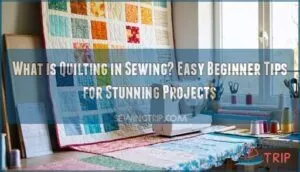 Quilting in sewing is like making a fabric sandwich – you layer a top piece, batting (the fluffy middle), and a backing fabric together.
Quilting in sewing is like making a fabric sandwich – you layer a top piece, batting (the fluffy middle), and a backing fabric together.
Then you stitch through all three layers to hold them in place. Think of it as creating cozy blankets, but quilting goes way beyond basic bedding.
You can make wall hangings, table runners, bags, and even clothing. The stitching patterns range from simple straight lines to intricate designs that turn your project into artwork.
Whether you’re hand-stitching by candlelight or using a sewing machine, quilting transforms separate pieces into something unified and beautiful. The real magic happens when you discover which techniques work best for different projects.
Table Of Contents
Key Takeaways
- You’ll create quilts by layering three essential components – a decorative top, batting for warmth, and backing fabric – then stitching through all layers to hold them together like a "fabric sandwich."
- You can choose between hand quilting for meditative precision or machine quilting for speed and versatility, with both methods requiring specific tools like rotary cutters, quilting rulers, and appropriate needles or feet.
- You’ll master quilting by starting with beginner-friendly patterns like Simple Squares, Nine Patch blocks, or Strip Quilts that teach fundamental techniques without overwhelming complexity.
- You’re joining over 21 million Americans in this fast-growing craft that transforms ordinary fabric pieces into functional, cozy blankets and artistic wall hangings through careful fabric selection and decorative stitching patterns.
Quilting Basics
Quilting transforms ordinary fabric into cozy masterpieces through three essential layers.
You’ll start with your quilt top, add batting for warmth, then secure everything with backing fabric—creating what quilters call a "quilt sandwich."
Think of it as building a fabric burger where each layer serves a purpose.
Fabric Selection matters tremendously.
Cotton works best for beginners because it’s forgiving and durable.
Your Layering Order follows a simple pattern: decorative top, fluffy batting middle, sturdy backing bottom.
Stitching Techniques hold everything together, whether you choose hand or machine methods.
Design Principles guide your Quilt Types—from simple patchwork to intricate appliqué.
Master these quilting basics and you’ll create beautiful, functional pieces that last generations.
Essential Quilting Tools
The right quilting tools transform your creative vision into reality.
You’ll need specific equipment to handle multiple fabric layers and achieve professional results.
Essential tools for successful quilting include:
- Rotary Cutters and quilting cutting mats for precise fabric preparation
- Quilting rulers for accurate measurements and straight cuts
- Quilting scissors and seam rippers for detailed work and corrections
- Marking tools like fabric pencils for pattern guidance
- Quilting irons and ironing essentials for crisp seams.
These quilting tools work together seamlessly.
Many quilters find specialized rotary cutter designs particularly helpful.
A walking foot attachment helps your sewing machine handle thick layers, while safety pins secure your quilt sandwich during stitching.
How to Make a Quilt
Creating your first quilt involves three main steps that you’ll master with practice and patience.
You’ll start by making a patchwork top from fabric pieces, then create a quilt sandwich with batting and backing, and finally add decorative stitching to hold everything together.
Patchwork Quilt Top
With your quilting tools ready, you’re set to create your first patchwork quilt top. This foundation layer showcases your artistic vision through careful fabric selection and thoughtful color palette choices.
Start by choosing quilt fabric that complements each other. Mix patterns and solids to create visual interest without overwhelming the eye. Next, focus on block arrangement—lay out your fabric pieces before sewing to see how colors and patterns interact.
When piecing begins, maintain a consistent 1/4-inch seam allowance for professional results. This precision keeps your blocks aligned and prevents puckering. Press seams as you go to maintain crisp edges. Many quilters find that hand sewing offers benefits, including relaxation.
Don’t worry about design complexity on your first project. Simple arrangements often create the most striking results. Whether you’re working with pre-cut squares or cutting your own fabric, remember that your patchwork tells a story through each carefully chosen piece and thoughtful placement.
Quilt Sandwich
With your patchwork quilt top complete, you’re ready to create the quilt sandwich—the foundation of successful quilting.
Start by laying your backing fabric face-down on a flat surface. Choose from various batting types like cotton for breathability or polyester for warmth and durability. This middle layer determines your quilt’s final feel and quilting density.
Consider exploring different quilt backing options for your project. Place your quilt top face-up over the batting, ensuring proper fabric alignment.
The layer composition requires careful attention—each piece should lie smooth without wrinkles. Pin all layers together using safety pins or basting stitches, spacing them every 4-6 inches.
This sandwich stability prevents shifting during quilting, creating the perfect base for your stitching work.
Using Quilting Stencils
Quilting stencils transform complex designs into manageable projects for any skill level. These thin plastic templates feature cut-out patterns that you trace onto your quilt sandwich. You’ll discover endless possibilities with quilting designs ranging from simple geometric shapes to intricate florals.
Here’s your step-by-step approach to mastering quilting stencils:
- Choose appropriate stencil materials – Select durable plastic templates that won’t bend or crack during use
- Master marking methods – Use erasable fabric markers, chalk, or transfer paper to trace patterns clearly
- Start with simple pattern complexity – Begin with basic shapes before advancing to detailed motifs
- Organize stencil storage – Keep templates flat in protective sleeves to prevent warping
Custom stencils let you create unique quilting stitches that reflect your personal style. Many options for stencil design products are available online. Practice your quilting techniques by following the marked lines with either hand or machine quilting tools. This method builds confidence while developing muscle memory for future free-motion projects.
Hand Quilting Techniques
Hand quilting transforms fabric layers into treasured heirlooms through deliberate stitches and mindful craftsmanship.
Through patient stitches and careful hands, ordinary fabric becomes an extraordinary legacy of love and artistry.
Thread selection matters—choose colors that complement your design while maintaining consistent stitch length for professional results.
Frame usage or quilting hoops keep fabric taut, preventing puckering during stitching.
Ergonomics play a vital role; position yourself comfortably to avoid strain.
These quilting techniques create distinctive dashed lines that machine stitches can’t replicate.
Master basic quilting stitches by practicing small sections first, building confidence with each careful motion through your quilt sandwich.
- Embrace the rhythm: Hand quilting becomes meditative once you find your personal stitching pace and breathing pattern.
Machine Quilting Techniques
While hand quilting offers meditative precision, machine quilting brings speed and versatility to your projects.
Your sewing machine quilting journey starts with understanding the right tools and settings. A walking foot prevents fabric layers from shifting during straight-line quilting. This attachment feeds all layers evenly, creating consistent quilting stitches without bunching.
For artistic freedom, switch to free motion quilting with a darning foot. Drop your feed dogs and guide the fabric manually for curved lines and intricate quilting designs.
Machine settings matter. Adjust stitch length and tension based on your batting thickness. Practice stitch regulation on scraps first—consistent speed creates even stitches.
Tool Purpose Key Benefit Best For Skill Level
Start small, practice often, and watch your confidence grow with each quilted piece.
Binding Your Quilt
After completing your quilting stitches, you’re ready for the final step that transforms your project into a finished masterpiece. Binding your quilt protects raw edges while adding visual appeal to your hard work.
Quilt binding involves wrapping fabric strips around your quilt’s perimeter. You’ll need to take several factors into account for professional results:
- Binding methods: Choose between machine binding for speed or hand binding for precise control
- Fabric choice: Select coordinating or contrasting fabrics that complement your overall design
- Binding width: Standard ¼-inch seam allowances work for most projects, but adjust for thicker batting
- Corner types: Master mitered corners for sharp, clean angles at each corner
- Quilt finishing: Plan your binding attachment order, starting from the bottom center edge
Start by attaching binding to your quilt’s front using matching thread. Leave several inches loose at the beginning, then work around the perimeter systematically for consistent results.
Quilt as You Go Method
The quilt as you go method transforms overwhelming quilting projects into manageable pieces.
You’ll work with smaller section sizes instead of wrestling with bulky layers through your machine’s throat. This approach lets you complete quilting stitches on individual blocks before joining sections together using various quilting techniques.
Choose from different backing options and explore design variations that suit your style. Efficiency tips include working on multiple blocks simultaneously and testing different joining methods.
This technique offers precision, creativity, and stress-free sewing for any skill level while saving valuable time.
Easy Quilt Blocks for Beginners
Beginning your quilting journey becomes manageable when you start with Simple Squares and Half-Square Triangles. These basic quilt blocks teach fundamental quilting techniques without overwhelming complexity.
Try a Nine Patch block using Charm Squares for your first project—it’s forgiving and builds confidence. Strip Piecing offers another beginner-friendly approach that creates stunning results quickly.
Focus on consistent seam allowances and choose fabrics with good contrast. These foundational blocks prepare you for more complex quilt patterns while developing essential beginner quilting skills through hands-on practice.
Beginner-Friendly Quilt Patterns
Starting your first quilt feels like opening a treasure chest of possibilities. Simple Squares and Strip Quilts make perfect entry points for beginner quilting.
These quilting patterns teach fundamental skills without overwhelming complexity. Charm Packs eliminate guesswork in fabric selection, while Rail Fence and Nine Patch blocks build your confidence with precise seaming.
Double-check fabric placement before stitching—this prevents costly mistakes. Templates streamline assembly, making these quilt projects manageable and enjoyable.
Master these basics, and you’ll create stunning quilts that showcase your growing quilting expertise beautifully.
Exploring The World of Quilting
Now that you’ve mastered beginner patterns, it’s time to expand your quilting horizons. The realm of quilting offers rich traditions and exciting innovations that’ll keep you inspired for years.
Quilting History reveals how this craft evolved from practical necessity to stunning art form. Early quilters created warmth from scraps, but today’s Modern Quilting movement embraces bold colors and unconventional designs. You’ll discover diverse Quilt Types, from traditional patchwork to contemporary art pieces.
Your quilting journey can include:
- Joining quilting guilds for hands-on workshops and community support
- Taking online classes to master new quilting techniques and quilting stitches
- Attending quilt shows to see innovative quilt patterns and Machine Features
- Building your fabric stash with smart Fabric Selection strategies
Each path deepens your understanding while connecting you to fellow quilters worldwide. The quilting community welcomes newcomers with open arms and endless encouragement.
Frequently Asked Questions (FAQs)
What is the difference between sewing and quilting?
Think you know the difference? You’re joining fabrics when sewing, but quilting layers three materials together.
Sewing creates garments and décor, while quilting specifically produces warm blankets through specialized stitching techniques.
What are the different types of quilting?
You’ll find five main quilting types:
Patchwork uses fabric pieces sewn together, appliqué attaches shapes onto backgrounds, whole cloth quilts single fabric, crazy quilts combine random scraps, and trapunto creates raised designs through stuffing.
What is quilting & how does it work?
Quilting layers fabric pieces with batting and backing to create warm, decorative blankets.
You’ll stitch through all layers using hand or machine techniques, securing them together while adding beautiful patterns and designs.
How to make a quilt using a sewing machine?
Over 70% of quilters use sewing machines for faster results.
You’ll layer your quilt top, batting, and backing, then secure with pins.
Use a walking foot and stitch in straight lines or curves to hold layers together beautifully, achieving faster results.
How are quilts made?
You’ll create quilts by layering three parts: a decorative top, batting for warmth, and backing fabric.
Sew these layers together using straight lines or curved patterns, then add binding around the edges for a finished look.
What is the difference between quilting and patchwork?
Patchwork creates the decorative top layer by piecing fabric scraps together into patterns.
You’re basically making a beautiful fabric puzzle.
Quilting then stitches through all three layers—top, batting, and backing—to hold everything together, creating a cohesive and functional piece of work.
What makes a quilting machine different from a sewing machine?
Your quilting machine packs more punch than a regular sewing machine.
It’s got a wider throat, longer arm, specialized feet, and can handle bulky layers without breaking a sweat.
Perfect for those chunky quilt sandwiches.
Can you use any sewing machine for quilting?
Like fitting a square peg in a round hole, you can use any sewing machine for quilting, but it’ll be challenging.
Regular machines work for small projects, though they’ll struggle with thick layers and large quilts.
Can you quilt a large quilt on a regular sewing machine?
Yes, you can quilt large projects on regular machines, but it’ll require patience and strategy.
Break your quilt into manageable sections, roll excess fabric carefully, and take frequent breaks to avoid frustration.
What does quilting mean in sewing?
You’re creating a warm sandwich when you quilt, it involves stitching decorative patterns through three layers: a fabric top, batting middle, and backing bottom.
This technique transforms separate pieces into cozy, durable blankets.
Conclusion
Surprisingly, over 21 million Americans now quilt regularly, making it one of the fastest-growing crafts today.
You’ve learned what quilting in sewing involves—from creating that essential fabric sandwich to mastering binding techniques.
Whether you choose hand quilting or machine methods, you’re joining a community that values both tradition and creativity.
Start with simple blocks and basic patterns. Don’t worry about perfection—every quilter began exactly where you’re now.
Your first finished quilt will be absolutely worth the effort.


